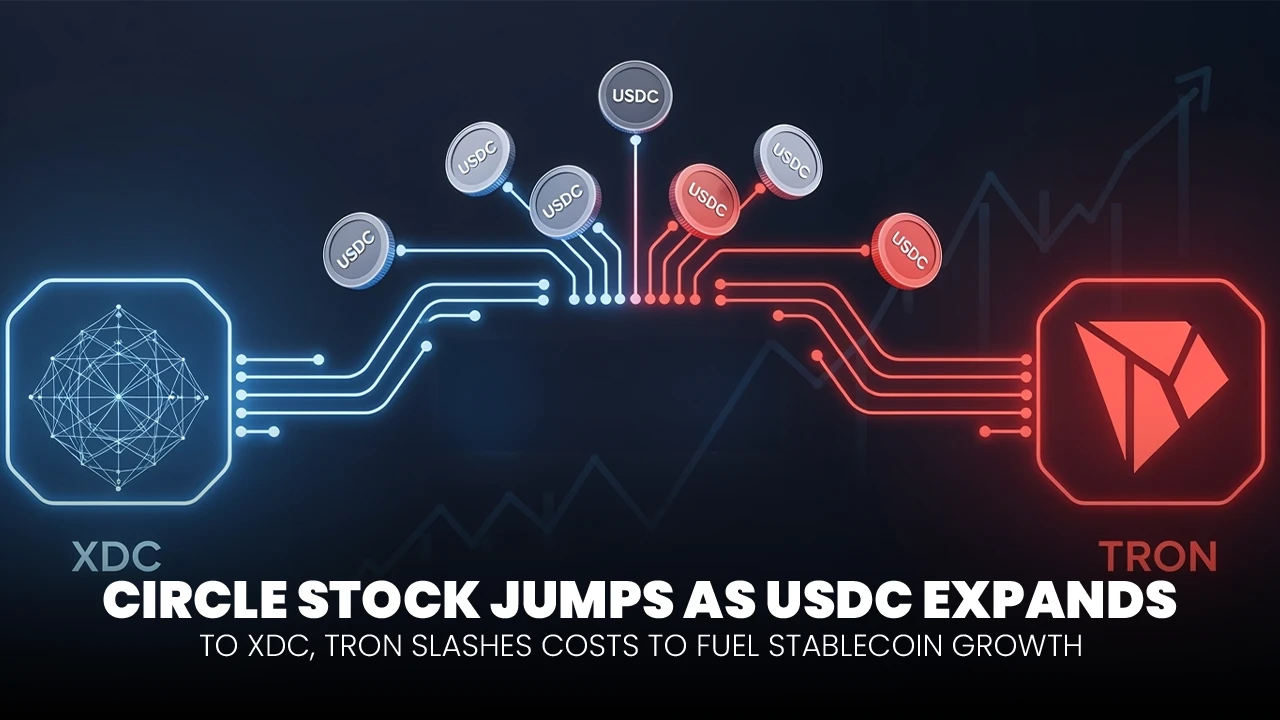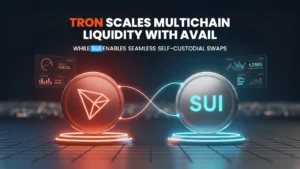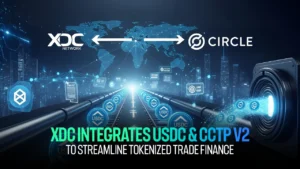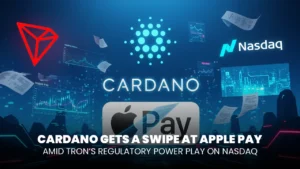USDC Expansion to XDC Network Boosts Circle as TRON Slashes Transaction Cost by 50%

Circle (CRCL) stock rose today after the company announced that native USDC and Cross-Chain Transfer Protocol V2 (CCTP V2) will be launched on the XDC Network, providing the blockchain-regulated stablecoin with liquidity and seamless cross-chain functionality.
- Institutional Benefits and Liquidity Gains
- Market Dynamics: Competition, Regulation, and Adoption
- Technical Foundations and the Role of Delegated Proof of Stake
- Key Metrics
- Social Reactions:
- XDC Foundation (@XDCFoundation):
- A developer’s commentary, Ketan Patel (@Ketan_Patell):
- Smooth Flow and Institutional Implications
- Conclusion
- Frequently Asked Questions About Circle Up as USDC Hits XDC; TRON Reduces USDT Cost
- What is the impact of USDC on XDC Network?
- How does CCTP V2 improve USDC transfers?
- Why is DPoS important for both XDC and TRON?
- How did Circle’s stock react to the integration?
- What advantage does TRON’s update bring to USDT?
- Glossary of Key Terms
The news comes just days after TRON unveiled a major energy-saving system designed to cut transaction costs by 50 percent for USDT transfers across its Delegated Proof of Stake (DPoS) network.
Together, these developments highlight a strategic shift in the stablecoin sector. Infrastructure upgrades are becoming just as critical as liquidity, as networks like XDC and TRON compete to provide enterprises, developers, and retail users with faster, cheaper, and more compliant rails.
According to Crypto Economy data, Circle’s stock now trades at approximately $126.54 per share, up 1.04% in the last 24 hours and rebounding from a recent 8.4% decline, as investors signal confidence in the company’s expanding role in blockchain finance.
Revenue data underscores the momentum. In Q2 2025, Circle reported $658 million in revenue, a 53% year-over-year increase, driven by a 90% surge in USDC circulation to $61.3 billion, with supply surpassing $65.2 billion in early August. While the company posted a net loss of $482 million, tied to IPO-related charges, the adoption of USDC across new networks, such as XDC, demonstrates expanding demand for stablecoin-based settlement.
ALSO READ: Cardano and XRP Join Forces for Wider Multichain Global Adoption
Institutional Benefits and Liquidity Gains
The integration of USDC into the XDC Network provides immediate technical and strategic benefits. Native issuance means that every token is redeemable directly from Circle on a 1:1 basis, removing the reliance on wrapped assets and preserving capital efficiency.
CCTP V2 builds on this by enabling cross-chain transfers using a burn-and-mint design, allowing users to seamlessly move USDC across chains without relying on custodial bridges. This system reduces risk, increases interoperability, and aligns with institutional requirements for compliance and efficiency.
For XDC, the benefits are clear. The Layer-1 blockchain, already optimized for trade finance and real-world asset tokenization, gains direct access to one of the most regulated and trusted stablecoins on the market. Its EVM compatibility ensures smooth integration into existing Ethereum-based developer tools, while its low transaction costs and Delegated Proof of Stake architecture guarantee scalability for global users.
A tweet from the XDC Network underscored the milestone:
Milestone: @USDC & CCTP V2 are coming to the XDC Network
This milestone strengthens XDC’s position in the global tokenization & settlement landscape.
With a $68B+ market cap, USDC is designed to maintain a stable value, and bring trusted liquidity and seamless settlement to DeFi… pic.twitter.com/TjTcvpONNH— XDC Network (@XDC_Network_) August 26, 2025
Market Dynamics: Competition, Regulation, and Adoption
Despite USDC’s growth, Circle still trails Tether’s USDT, which commands a market capitalization of more than $167 billion and dominates emerging markets. Much of USDT’s success is tied to TRON, where its DPoS model powers low-fee, high-speed transactions. TRON’s newly launched energy-saving system is expected to halve costs for USDT users, further cementing its position in regions reliant on low-cost remittances and trading.
ALSO READ: Tron Strengthens Global Stablecoin Grip as Asia Becomes the Next Battleground
Circle’s differentiation lies in its compliance framework. The GENIUS Act of 2025 has formalized stablecoin regulation in the United States, giving Circle an edge as one of the few issuers operating within a regulated framework. Partnerships such as enabling USYC collateral on Binance and its application for a national trust bank further extend Circle’s institutional footprint.
Even so, analysts at Goldman Sachs and JPMorgan remain measured, cautioning that Circle’s profitability path is complicated by high competition and reliance on adoption cycles. Still, the expansion to XDC signals Circle’s intention to grow aggressively across networks that align with its enterprise-focused strategy.
Technical Foundations and the Role of Delegated Proof of Stake
The XDC Network’s Delegated Proof of Stake consensus model is central to the story. In a DPoS system, token holders elect a fixed set of validators who produce blocks, a design that delivers higher throughput and lower costs than most Proof-of-Stake networks.
This efficiency is critical for stablecoins. With USDC now native on XDC, transactions can be confirmed quickly and cost fractions of a cent, while still maintaining security and decentralization through delegate accountability. The combination of CCTP V2 and DPoS means USDC can flow across multiple blockchains at scale without compromising regulatory trust or capital safety.
TRON provides a parallel example. Its DPoS model already supports the largest share of USDT circulation globally, and its latest energy-saving update highlights how optimizing validator performance can further reduce costs. Both XDC and TRON demonstrate that DPoS networks are positioning themselves as the backbone of infrastructure for the stablecoin era.
Key Metrics
| Metric | Value | Notes |
| Q2 2025 Revenue | $658 million | Up 53 % YoY |
| USDC Circulation | $61.3B → $65.2B | 90 % YoY growth |
| Circle Stock Price | ~$126.54 | Up 1.04 % post-news |
| Competition | USDT > $167B cap | Dominant on TRON DPoS |
Social Reactions:
XDC Foundation (@XDCFoundation):
Circle gets REAL with real world asset and trade finance focused XDC Network.
USDC + CCTP V2 are set to launch on XDC, bringing the world’s largest regulated stablecoin to a blockchain purpose-built for trade finance and tokenization.
Welcome to the XDC ecosystem, @USDC and… pic.twitter.com/Zgu4kebdP8
— XDC Foundation (@XDCFoundation) August 26, 2025
A developer’s commentary, Ketan Patel (@Ketan_Patell):
Huge milestone. Native USDC on XDC feels like a game-changer for enterprise adoption. 🚀 No wrapping, no bridges—just native flow. That’s the kind of efficiency DeFi needs 🤓. #XDC #XDCNetwork https://t.co/riu9GoqdCV
— metamitra (@Ketan_Patell) August 26, 2025
Smooth Flow and Institutional Implications
Taken together, Circle’s USDC expansion and TRON’s transaction-cost reduction reflect a structural transformation of the stablecoin market. Compliance and regulation remain Circle’s strong suit, while low-cost scalability keeps TRON entrenched in retail and emerging markets.
Delegated Proof of Stake consensus links both moves. DPoS provides the scalability, efficiency, and governance models required for stablecoins to serve billions of users worldwide. Circle’s integration with XDC and TRON’s energy efficiency update show how DPoS networks are emerging as the critical foundation for both institutional and consumer adoption.
This dual momentum creates a virtuous cycle: Circle expands the stablecoin’s reach into institutional finance, TRON deepens its retail penetration, and DPoS networks prove their capacity to carry global transaction volumes efficiently.
Conclusion
Circle’s stock rebound illustrates renewed investor confidence in its strategy of expanding regulated stablecoin access through enterprise-grade networks. The launch of native USDC and CCTP V2 on XDC Network strengthens the blockchain’s role in trade finance and tokenized assets, powered by Delegated Proof of Stake efficiency.
Meanwhile, TRON’s 50 % cost reduction for USDT transactions highlights the ongoing battle for infrastructure leadership in stablecoins. Together, these moves underscore a new phase of competition where liquidity, compliance, and efficiency converge to decide the future of blockchain settlement.
Frequently Asked Questions About Circle Up as USDC Hits XDC; TRON Reduces USDT Cost
What is the impact of USDC on XDC Network?
Native USDC provides regulated stablecoin liquidity with low-risk settlement, boosting trade finance and DeFi use cases.
How does CCTP V2 improve USDC transfers?
It eliminates wrapped tokens by burning USDC on one chain and minting it on another.
Why is DPoS important for both XDC and TRON?
DPoS ensures fast, low-cost processing and scalable validator systems, ideal for global stablecoin use.
How did Circle’s stock react to the integration?
CRCL shares rose about 1 % to ~$126.54, recovering from recent weekly losses.
What advantage does TRON’s update bring to USDT?
Its new energy-saving system halves transaction costs, reinforcing TRON’s role in low-fee stablecoin transfers.
Glossary of Key Terms
- USDC – Circle’s regulated dollar-pegged stablecoin, fully redeemable 1:1.
- CCTP V2 – Circle’s Cross-Chain Transfer Protocol enabling seamless burn-and-mint transfers.
- XDC Network – DPoS-based blockchain optimized for trade finance and tokenization.
- Delegated Proof of Stake (DPoS) – A consensus model where token holders elect validators for scalable and low-cost block production.
- Stablecoin – A cryptocurrency pegged to fiat, designed for low volatility and payments.
- Real-World Assets (RWA) – Tangible assets digitized and represented on blockchain.
- Trade Finance – Tools and products facilitating international trade transactions.
- Wrapped Token – A tokenized version of an asset on a different blockchain.
- Capital Efficiency – Achieving maximum utility with minimal locked or fragmented capital.
- Liquidity – Ease of converting assets into cash or equivalents.




